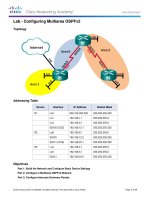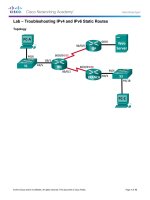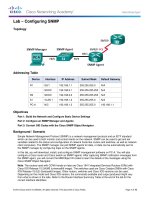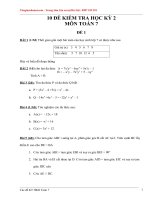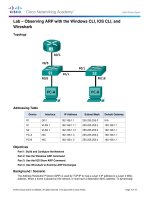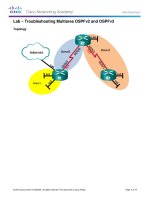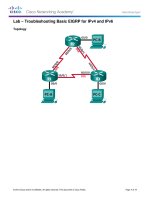Sample paper 2 kho tài liệu bách khoa
Bạn đang xem bản rút gọn của tài liệu. Xem và tải ngay bản đầy đủ của tài liệu tại đây (68.51 KB, 21 trang )
Sample Question Paper – II
Time : 3 Hours
Maximum Marks :70
General Instructions
(i)
(ii)
All questions are compulsory.
There is no overall choice. However, an internal choice has been provided in one question
of two marks, one question of three marks and one question of five marks. You have to
attempt only one of the choices in such questions.
(iii) Question number 1 to 5 are very short answer questions, carrying 1 mark each.
(iv) Question number 6 to 12 are short answer questions, carrying 2 marks each.
(v) Question number 13 to 24 are also short answer questions, carrying 3 marks each.
(vi) Question number 25 to 27 are long answer questions, carrying 5 marks each.
(vii) Use of calculators is NOT permitted. However, you may use Log Tables, if necessary.
(viii) You may use the following physical constants wherever necessary:
c = 3 × 108 ms–1
h = 6.6 × 10–34 Js
e = 1.6 ì 1019 C
1.
2.
3.
4.
à0 = 4 ì 107 T mA1
Write the SI unit of (i) potential gradient (ii) electric dipole moment
1
Name any two types of button cells.
1
State the main function of a modem.
1
A thin prism of refracting angle 2° deviates an incident ray through an angle of 1°. Find the
value of refractive index of the material of the prism.
1
S. Chand & Company Limited
5.
A radioactive nucleus decays by emiting a β-particle. How will the proton-neutron ratio of
the daughter nucleus change as compared to the parent nucleus?
1
6.
Name one ohmic material and one non-ohmic device. Draw V-I graph for each.
7.
Define angle of dip at a place. How does its value change as one goes from magnetic pole to the
magnetic equator?
2
8.
In the given circuit diagram, calculate the value of R using Kirchhoff’s laws.
2A
2
E
10V
2.5
2
4
R
1A
9.
Two identical bar magnets P and Q are placed in two identical uniform magnetic fields as
shown in the figure. Justify that both the magnets are in equilibrium. Which one of these is
in stable equilibrium? Give reasons for your answer.
2
P
N
Q
S
S
N
S. Chand & Company Limited
10.
The truth table of a logic gate is given below
INPUTS
OUTPUT
A
B
Y
0
0
1
1
0
1
0
1
1
1
1
0
Name the gate and draw its logic symbol.
11.
2
A student is asked to calculate the ratio of electric flux through the surfaces of spheres S1 and S2
with charges placed inside, as shown in the figure. He gets the answer as 4 : 1. Check the
correctness of the answer by actually calculating the electric flux ratio through the two surfaces
and state whether his answer is correct or incorrect.
2
S1
+1 mC
5cm
S2
3mC
10cm
12.
In a part of the circuit shown in the figure, the rate of heat dissipation in 4Ω resistor is 100 J/s.
Calculate the heat dissipated in the 3Ω resistor in 10 seconds.
2
S. Chand & Company Limited
R1
R2
4
2
R3
3
OR
A copper voltameter and a bulb of rating 100W-220V are connected in series across a DC
supply. If 0.198g of copper is deposited on the electrode in 40 minutes, calculate the potential
difference across the bulb assuming that its resistance is approximately constant. E.C.E of copper = 0.00033 g/C.
13.
Name the constituent radiation of electromagnetic spectrum which
(i) is similar to the radiations emitted during decay of radioactive nuclei.
(ii) has its wavelength range between 390 nm and 770 nm.
(iii)is used in satellite communication.
(iv) is absorbed from sunlight by the ozone layer
(v) is used for studying crystal structures.
(vi) produces intense heating effect.
3
14.
Define the terms ‘solar constant’ and ‘solar luminosity’. Write the relation between the two. 3
15.
What do the acronyms LASER and LED stand for? Name the factor which determines (i) frequency (ii) intensity of light emitted by LED. State the basic difference between the light
emitted by LASER and LED.
3
S. Chand & Company Limited
16.
17.
18.
19.
20.
21.
22.
22.
A proton and an alpha particle enter at right angles in to a uniform magnetic field of intensity B.
Calculate the ratio of the radii of their paths, when they enter the field with the
(i) same momentum,
(ii) same kinetic energy.
3
Write two differences between interference and diffraction.
Two plane monochromatic waves propagating in the same direction with amplitudes A and 2A
and differing in phase by π/3 superpose. Calculate the amplitude of the resultant wave.
3
A ray of light goes from medium 1 to medium 2. Velocity of light in the two media are c1 and c2
respectively. For an angle of incidence θ in medium 1, the corresponding angle of refraction in
medium 2 is θ/2.
(i) Which of the two media is optically denser and why?
3
(ii) Establish the relationship between θ, c1 and c2.
Calculate the de Broglie wavelength associated with an electron of energy 200 eV. What will be
the change in this wavelength if the accelerating protential is increased to four times its earlier
value?
3
Prove mathematically that the fraction N/N0, of a radioactive element left over after a time t
equals 1/x where x = 2t/T and T denotes half life period of the radioactive element.
3
Mention any two special characteristics of light sources used in optical communication. Explain the meaning of the terms (i) sensitivity (ii) responsivity of the detector used in an optical
communication system. Name two such optical detectors.
3
Two metallic wires of the same material and same length but different cross sectional areas are
joined together (i) in series (ii) in parallel, to source of emf. In which of the two wires will the
drift velocity of electron be more in each of the two cases and why?
3
OR
Six equal resistors, each of value R, are joined together as shown in the given figure. Calculate
the equivalent resistance across AB.
S. Chand & Company Limited
R
A
R
C
R
D
R
E
R
B
R
F
If a supply of emf E is connected across AB, compute the currents through the arms DF and that
through the battery.
23.
A rectangular coil P is moved from a point A to another point B with uniform velocity v through
a region of a uniform magnetic field acting normally inwards as shown in the figure. Show
graphically
(i) the variation of magnetic flux associated with the coil with time.
(ii) variation of induced emf across points X and Y of the coil with time.
A
X
P
B
v
X
X
X
X
X
X
X
X
X
Y
Explain the nature of variation in magnetic flux as represented by the graph in first case.
S. Chand & Company Limited
3
24.
Two convex lenses A and B of an astronomical telescope having focal lengths 5 cm and 20 cm
respectively, are arranged as shown in the figure.
A
B
15cm
(i) Which one of the two lenses you will select to use as the objective lens and why?
(ii) What should be the change in the distance between the lenses to have the telescope in its
normal adjustment position?
(iii)Calculate the magnifying power of the telescope in the normal adjustment position.
25.
Explain the formation of the depletion layer and the barrier potential in a p-n junction
diode. Also explain with the help of a circuit diagram, its use as a full wave rectifier. Draw the
input and the corresponding output voltage time waveforms.
5
26.
Two circular metal plates, each of radius 10 cm, are kept parallel to each other at a distance of
1 mm. What kind of capacitor do they make? Mention one application of this capacitor.
If the radius of each of the plates is increased by a factor of √2 and their distance of separation
decreased to half of its initial value, calculate the ratio of the capacitance in the two cases.
Suggest any one possible method by which the capacitance in the second case be increased by
n times.
5
S. Chand & Company Limited
27.
Distinguish between the terms resistance and impedance of an a.c. circuit. A capacitor C and a
resistor R are connected in series in an a.c. circuit. Deduce, by drawing phasor diagram, a
mathematical expression for the impedance of this circuit. How will this impedance be affected
when the frequency of the applied signal is decreased and why?
2+2+1=5
OR
An inductor L, a capacitor C and a resistor R are connected in series in an a.c. circuit. Deduce,
with the help of suitable phasor diagrams, a mathematical expression for impedance of this
circuit.
What is meant by resonance of this circuit? Prove that this circuit exhibits resonance at a frequency give by
1
3+1+1
2 ì LC
ANSWERS
1.
2.
(i)
Volt/m or N/C
(ii) Coulomb metre
ẵ+ẵ
Any two of the following:
½+½
Mercury cell, Lithium cell, Silver oxide cell, Alkaline cell
3.
Statement of function of a modem:
modulation demodulation
modem converts digital to analog signals (modulation)
and vice-versa (demodulation)
4.
µ = 1.5
1
5.
There will be increase in the proton-neutron ratio
1
S. Chand & Company Limited
6.
Metallic conducting wire/resistance wire
½
I
V
p-n junction/copper voltameter or any other
I
½
I
V
7.
V
Angle of dip at a place is the angle that earth’s magnetic field makes with the horizontal at that
place. As we move from magnetic pole to the magnetic equator the angle of dip decrease from
90° to 0°.
1
S. Chand & Company Limited
8.
A
2A
10V
D
E
2.5
4
2A
B
x
1A
1A
C
x = 2 + 1 = 3A
(junction rule)
½
from loop ADCBA
–2.5 × 2 – 3 × R + 10 = 0
½
–5 + 10 – 3 R = 0
R = 5/3 Ω
9.
1
In both the magnets
net force = 0
net torque = 0
hence equilibrium
Magnet Q is stable because its PE is minimum.
OR
½+½
If the magnet P is disturbed, a torque acts on it that tries to align it in opposite direction, whereas
for magnet Q the torque brings it back to the same alignment.
1
S. Chand & Company Limited
10.
NAND gate
1
A
Y
B
11.
Flux through S1
1 =
=
q1 + q2
0
ẵ
4 ì 10 16
8.85 × 10 −12
= 4.52 × 105 (N/C) m2
½
Flux through S2
φ2 = 4.52 ì 105 (N/C) m2
ẵ
Flux is same through both the surfaces and his answer is incorrect.
½
12.
I1
R1
R2
4
2
R3
I2
6I1 = 3I2 ⇒
3
I2 = 2I1
S. Chand & Company Limited
½
I22 = 4I12
Rate of heat dissipated in R1 = R1 I21 = 4I12 = 100 (given)
I12 = 25 A2
½
2
Rate of heat dissipation in R3 = R3 I2 =
4I12
×3
= 4 × 25 ì 3 J/s
= 300 J/s
ẵ
In 10 second, heat dissipated in R3 = 300 ì 10 = 3000 J
ẵ
OR
m
= ItZ
0.198 = I ì 40 ì 60 ì 0.00033
I
= 1/4 A
ẵ
2
Resistance of the bulb R =
P.D. across the bulb
V
P
220 × 220
=
100
= 484
ẵ
= IR
1
ì 484
4
= 121 V
=
S. Chand & Company Limited
ẵ
13.
(i)
-rays
(ii) Visible light
(iii) Microwaves
(iv) Ultraviolet
(v) X-rays
(vi) Infrared rays
14.
(ẵ ì 6 = 3)
Solar constant (S) is defined as the amount of radiant energy received per second by a unit area
of a perfectly black body surface held at right angle to the direction of sun rays at the mean
distance of the earth from the sun.
1
Solar luminosity (Ls) is defined as amount of total energy emitted per second by the sun in all
directions.
1
Ls = 4πr2S
1
where r is the mean distance of the earth from the sun.
15.
LASER — Light Amplification by Stimulated Emission of Radiation
½
LED
½
(i)
— Light Emitting Diode
Frequency of light emitted by LED depends on gap in energy band of PN junction.
½
(ii) Intensity of light emitted by LED is determined by its forward current at PN junction. ½
16.
LASER: Light emitted is coherent and monochromatic
½
LED: Light emitted is noncoherent
½
R = mv/Bq
½
(i)
For same momentum
S. Chand & Company Limited
R = p/Bq
½
Rα / Rp = qp / qα = ½
½
(ii) For same K.E.
R=
RP
=
Rα
2mk
Bq
mP qα
.
mα qP
½
1 2
. = 1:1
4 1
Any two differences
=
17.
AR =
=
18.
½+½
A12 + A22 + 2 A1 A2 cos φ
A2 + (2 A) 2 + 2 A × 2A cos
1
3
= 7A
1
Medium 2 is optically denser
ẵ
sin i
à=
sin r
S. Chand & Company Limited
=
sin
= 2 cos
2
sin
2
1
à = c1 / c2
ẵ
c1 / c2 = 2 cos θ/2 OR
19.
θ = 2 cos (c1/2c2)
–1
E = 200 eV = 200 ì 1.6 ì 1019 J
=
=
ẵ
h
2mE
6.6 ì 1034
2 × 9.1 × 10 −31 × 3.2 × 10 −17
m
= 0.8646 Å
1
Wave length would become ½ of its initial value
20.
1
–λt
N = N0 e
⇒
N0 / N = e
λt
1
½
N
Log e 0 = λ t
N
½
Loge 2
T
½
λ=
N
Log e 0
N
t
= T Log e 2
S. Chand & Company Limited
½
t
= Log e 2 T
= Logex
21.
½
N0
=x
N
N
1
=
N0 x
Characteristics (any two)
(i)
½
Size of the source should be small
(ii) Light source should produce monochromatic light
(iii) Should be capable to rapid switching
Sensitivity: It is the measure of the ability of a detector and determines how weak a signal can
be detected.
Responsivity: The ability of the optical detector to respond quickly to the changing light pulses
that are rapidly switching ON and OFF.
Name of optical detectors (any two)
Silicon photo-diodes, Avlanche Photo Diodes (APD), photo-transistors, photo-resistors.
22.
I = neAvd
½
(i)
In series, I is constant
½
1
vd ∝
A
½
S. Chand & Company Limited
∴ thinner wire will have greater vd
(ii) In parallel, V is same
1
R
I1 A 1
=
I 2 A2
I∝
From above
R =ρ.
l
A
½
I1 A1 vd 1 A1
=
.
=
I 2 A2 vd 2 A2
∴ vd1 = vd2
i.e. same drift velocity for both wires
½
OR
22.
D
R
R
R
R
R
R
E
R
R
R
R
A
R
F
B
A
S. Chand & Company Limited
B
Total resistance
R′ =
I
I
I
I
= +
+
R′ R 2R 2R
R
2
1
Current through battery =
2E
R
Current through DF = 0.
1
23.
Explanation variation of magnetic flux with time, magnetic flux is proportional to the area
of coil associated with flux. Area of the coil in the field increases linearly with time. Then
remains constant when the coil is completely in the magnetic field. After this flux decreases linearly with time and goes to zero till it comes out of the magnetic field.
1½
24.
(i)
Objective lens – B because it has larger focal length and larger aperture.
(ii) The distance between the lenses has to the increased by 10 cm.
(iii) m =
=4
fo
fe
½
1
½
S. Chand & Company Limited
½
25.
Explanation of depletion layer
1
Explanation of barrier potential
1
Circuit diagram of full wave rectifier
1½
Description of how it is used as full wave rectifier
1
V
t
t
26.
(i)
Parallel plate capacitor. Applications:-
(a) to store electrostatic energy
(b) it can be used in an oscillatory circuit, when combined with an inductor. ½
(ii) C1 =
ε0 A1
d1
=
ε0 πr 2
d
( )
ε0 π r 2
ε A
C2 = 0 2 =
d
d2
2
2
S. Chand & Company Limited
½
=
4ε 0 πr 2
d
½
C1 1
=
C2 4
1
(iii) (a) By introducing a dielectric having a dielectric constant n, between the plates.
(b) By decreasing the distance between the plates by a factor of n
(c) By increasing the area of plates n times (any one)
(d) By increasing the area of plates
between plates by a factor
27.
n times and simultaneously decreaing the distance
n.
1
Distinction between resistance and impedance.
2
Circuit diagram for series CR circuit. Phasor diagram for series CR circuit. Derivation of mathematical expression.
½
Z = R2 +
1
1
ω2 C 2
Z increases because of an increase in the impedance
1
of the capacitor.
ωC
1
OR
Circuit diagram for series LCR circuit
½
Phasor diagram for series LCR circuit
½
S. Chand & Company Limited
Derivation of mathematical expression
1/ 2
2
1
Z = R 2 + ωL −
ωC
2
The current in the circuit rises to a maximum value due to its impedance attaining its minimum
value.
Proof of formula for resonant frequency.
S. Chand & Company Limited
1
